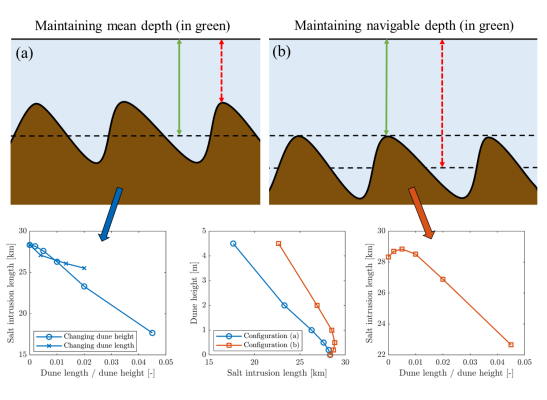S.J. Geerts1,2*, W.M. van der Sande1, S.J.M.H. Hulscher1, B.J. Geurts2, P.C. Roos1
1 Department of Water Engineering and Management, Faculty of ET, University of Twente, Enschede, the Netherlands; 2 Mathematics of Multiscale Modelling and Simulation (3MS), Faculty of EEMCS, University of Twente, Enschede, the Netherlands;
* Corresponding author: s.j.geerts@utwente.nl
Introduction
Saltwater intrusion in estuaries can pose a critical issue with significant implications for human activities such as industry, agriculture and drinking water extraction, and can be unfavourable to environmental sustainability. This phenomenon arises when saline water infiltrates the estuarine system, potentially leading to a shortage of freshwater. The intensity of salt intrusion is influenced by various factors, of which freshwater river flushing and the amount of vertical transport in the flow are key predictors (Geyer & MacCready, 2014).
This study investigates the impact of estuarine sand dunes, bedforms with heights in the order of meters and lengths of tens to hundreds of meters (Zorndt et al., 2011), on salt intrusion. Estuarine sand dunes potentially increase the net vertical flux, by an increase in large-scale turbulence, tide-averaged circulation cells and resonant internal waves. An increase in vertical transport generally decreases stratification and reduces salt intrusion. We determine the potential of estuarine sand dunes as a nature-based solution against salt intrusion and investigate the complex salt transport dynamics over these bedforms on an estuarine scale.
Objective and Methods
We investigate the influence of estuarine sand dunes on salt intrusion using an idealised morphostatic model with 2DV geometry, implemented in Delft3D-FLOW. This enables us to specifically study the effect of vertical flow behaviour without possible interference from other estuarine-scale parameters. Our model is designed to investigate estuarine systems that can be approximated as a single-channel estuary with relatively uniform geometry. In this study, model settings are based on the Rotterdam Waterway, the Netherlands, during low river flow velocities, when salt intrusion is most detrimental. The model effectively captures most of the flow, salt transport behaviour, and turbulent eddy diffusivity representative of field measurements of the Rotterdam Waterway (de Nijs et al, 2011) and other modelling studies (Dijkstra et al., 2022).
We focus on two dune configurations: we vary the dune characteristics (such as dune height, dune length and asymmetry) while (a) maintaining the mean water depth, and (b) maintaining the navigable depth, both visualised in Figure 1. We determine the influence of these geometric changes on the salt intrusion length, which is defined as the tide-averaged distance from the seaward end where the maximum concentration over the water column equals 1 ppt.
Results
Across all model runs, the presence of estuarine sand dunes does not qualitatively change the dominant transport mechanisms and stratification. A different salt intrusion length may form by a changing balance of transport components. (a) An increase in dune height enhances vertical advective transport, which reduces the salt intrusion length significantly (bottom-left panel in Figure 1). Similarly, a decrease in dune length increases the dune slope and enhances the vertical exchange, although the influence is not of the same order of magnitude for dune lengths evaluated (50 m to 250 m). Dune asymmetry has a negligible influence on our model results, which likely results from the hydrostatic assumption. (b) Small dredged dunes increase the salt intrusion as the channel is deepened (bottom-right panel). For larger dune heights, salt intrusion is significantly decreased, which follows the trend of method (a) (middle panel). The change in salt intrusion length can be attributed to advective vertical transport, as changes in dispersive transport are negligible. Generally, the salt intrusion length is inversely proportional to the mean amount of vertical transport throughout the region of stratification.

Top: visualisation of the two dune configurations that (a) maintain mean depth and (b) maintain navigable depth. Maintained depths are indicated in green and changing depths are indicated in red. Bottom: Influence of changing dune geometry on salt intrusion length with the panels; left: dune configuration (a), right: dune configuration (b) and middle: dune height only for both configurations.
References
de Nijs, M.A.J., Pietrzak, J.D. & Winterwerp, J.C., (2011). Advection of the salt wedge and evolution of the internal flow structure in the Rotterdam Waterway. Journal of Physical Oceanography, 41 (1), 3-27. https://doi.org/10.1175/2010JPO4228.1
Dijkstra, Y.M., Schuttelaars, H.M., & Kranenburg, W.M. (2022). Salt transport regimes caused by tidal and subtidal processes in narrow estuaries. Journal of Geophysical Research: Oceans, 127. https://doi.org/10.1029/2021JC018391
Geyer, W.R., & MacCready, P. (2014). The estuarine circulation. Annual review of fluid mechanics, 46, 175–197. https://doi.org/10.1146/annurev-fluid-010313-141302
Zorndt, A.C., Wurpts, A., & Schlurmann, T. (2011). The influence of hydrodynamic boundary conditions on characteristics, migration, and associated sand transport of sand dunes in a tidal environment: A long-term study of the Elbe estuary. Ocean Dynamics, 61, 1629–1644. https://doi.org/10.1007/S10236-011-0452-1


